Never miss another geomagnetic storm. Sign up for Space Weather Alerts and you'll receive a text message when magnetic storms erupt. Aurora tour guides and professional astronomers use this service. You can, too! | | |
PARTIAL SOLAR ECLIPSE NEXT WEEK: On Tuesday, Oct. 25th, the New Moon will pass in front of the sun, producing a partial solar eclipse. The eclipse zone includes most of Europe, north Africa, parts of Asia and the Middle East. As much as 82% of the sun will be covered, turning the solar disk into a skinny crescent at maximum eclipse. Live webcasts: England (Royal Greenwich Observatory); France (Reims Planetarium)
POWERFUL GAMMA-RAY BURST MADE CURRENTS FLOW IN THE EARTH: Astronomers have never seen anything like it. On Oct. 9, 2022, Earth-orbiting satellites detected the strongest gamma-ray burst (GRB) in modern history: GRB221009A. How strong was it? It caused electrical currents to flow through the surface of our planet. Dr. Andrew Klekociuk in Tasmania recorded the effect using an Earth Probe Antenna:
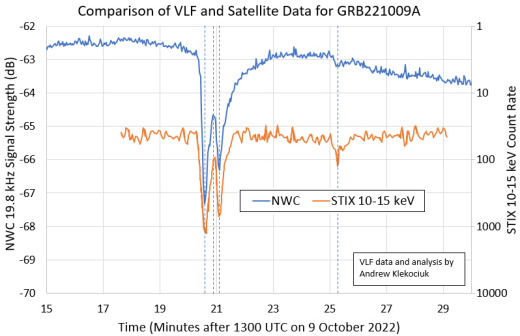
Note: STIX data have been flipped (increasing counts go down) to ease comparison of the two waveforms.
The blue curve is a signal from Klekociuk's antenna, which was sensing VLF (very low frequency) currents in the soil at the time of the blast. The orange curve shows the gamma-ray burst recorded by the STIX telescope on Europe's Solar Orbiter spacecraft, one of many spacecraft that detected the event. The waveforms are a nearly perfect match.
"I am a climate scientist at the Australian Antarctic Division--that's my day job," says Klekociuk. "VLF is my hobby. I started doing VLF radio measurements in the 1970's when I was in high school. This is the first time I have detected a gamma-ray burst."
Klekociuk's unusual "ham rig" uses Earth itself as a giant antenna. In his back garden there are two metal spikes stuck into the ground 75 meters apart. They are connected to a receiver via buried wires. In recent years amateur radio operators have been experimenting with this weird kind of antenna to detect VLF radio signals circling our planet in the Earth-ionosphere waveguide. Earth's crust forms one of the waveguide's walls, allowing Earth Probe Antennas to detect distant transmitters.
"During the gamma-ray burst I detected flickering from multiple stations," says Klekociuk, who made this map showing transmission paths illuminated by the GRB:

Above: NWC, VTX3, Mokpo and NML are VLF transmitters Klekociuk monitors using his Earth Probe Antenna. GRB effects were observed for all except NML, which was outside the radiation footprint.
Researchers have known since 1983 that gamma-ray bursts can ionize Earth's atmosphere and, thus, disturb the great waveguide. This appears to be the first time anyone has recorded the effect using an Earth Probe Antenna.
The outburst on Oct. 9th shocked astronomers. Consider this tweet from Phil Evans of the University of Leicester: "It's bright. Really bright. Like, stupidly really bright." Evans works with data from NASA's Swift gamma-ray observatory, and the overflowing signal had apparently broken some of his plotting software.
Data from NASA spacecraft have since pinpointed the burst. It came from a dusty galaxy 2.4 billion light years away, almost certainly triggered by a supernova explosion giving birth to a black hole. This is actually the closest GRB ever recorded, thus accounting for its extreme intensity.
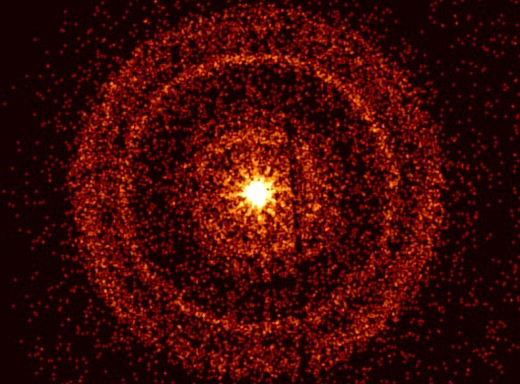
Above: The afterglow of GRB 221009A about an hour after it was first detected. Credit: NASA/Swift. [more]
"In our research group, we've been referring to this burst as the 'BOAT', or Brightest Of All Time," says Jillian Rastinejad, an astronomer at Northwestern University who has been monitoring the burst's afterglow using the Gemini South Telescope in Chile. "When you look at the thousands of bursts gamma-ray telescopes have been detecting since the 1990s, this one really stands apart."
Meanwhile, other observers in the UK and Germany have also reported ionospheric disturbances resulting from the burst. They all used regular above-ground antennas.
2.4 billion light years away... Now that's DXing.
A sharable version of this story may be found here.
Realtime Space Weather Photo Gallery
Free: Spaceweather.com Newsletter
"ALWAYS AND FOREVER" PREMIUM SPACE PENDANT: Are you looking for an unforgettable gift? Consider the Always and Forever Space Pendent. On Oct 9, 2022, the students of Earth to Sky Calculus launched it to the stratosphere onboard a cosmic ray research balloon:
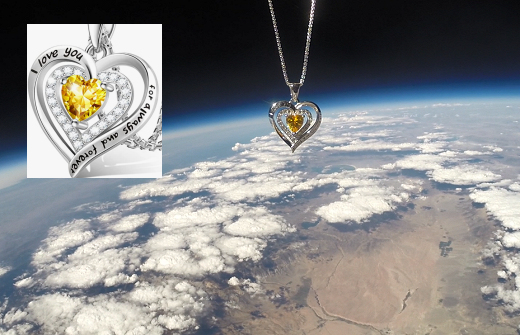
You can have it for $199.95. Engraved with the words "I love you always and forever", this 18K gold-plated pendant has a heart-shaped citrine crystal in the middle surrouunded by a ring of glittering 5A cubic zirconia nuggets. It is a visually striking premium pendant that makes a once-in-a-lifetime Christmas, anniversary or birthday gift.
The students are selling space pendants to pay the helium bill for their cosmic ray ballooning program. Each one comes with a greeting card showing the jewelry in flight and telling the story of its trip to the stratosphere and back again.
Far Out Gifts: Earth to Sky Store
All sales support hands-on STEM education
Realtime Aurora Photo Gallery
Free: Spaceweather.com Newsletter
Every night, a network of
NASA all-sky cameras scans the skies above the United States for meteoritic fireballs. Automated software maintained by NASA's Meteoroid Environment Office calculates their orbits, velocity, penetration depth in Earth's atmosphere and many other characteristics. Daily results are presented here on Spaceweather.com.
On Oct 18, 2022, the network reported 14 fireballs.
(7 sporadics, 6 Orionids, 1 southern Taurid)
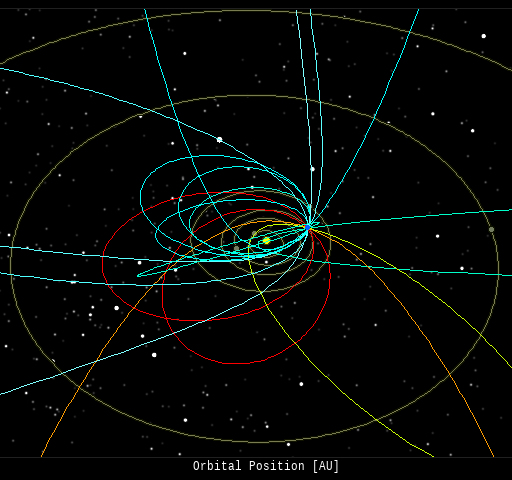
In this diagram of the inner solar system, all of the fireball orbits intersect at a single point--Earth. The orbits are color-coded by velocity, from slow (red) to fast (blue). [Larger image] [movies]
Potentially Hazardous Asteroids (
PHAs) are space rocks larger than approximately 100m that can come closer to Earth than 0.05 AU. None of the known PHAs is on a collision course with our planet, although astronomers are finding
new ones all the time.
On October 19, 2022 there were 2300 potentially hazardous asteroids.
 |
Recent & Upcoming Earth-asteroid encounters: | Asteroid | Date(UT) | Miss Distance | Velocity (km/s) | Diameter (m) |
| 2013 SL20 | 2022-Oct-14 | 6.3 LD | 12.2 | 45 |
| 2022 UM1 | 2022-Oct-14 | 2 LD | 8.2 | 14 |
| 2022 TK1 | 2022-Oct-14 | 10 LD | 13 | 17 |
| 2022 UQ | 2022-Oct-14 | 13.1 LD | 10.7 | 17 |
| 2022 UF | 2022-Oct-15 | 2.2 LD | 11.2 | 13 |
| 2022 TM2 | 2022-Oct-15 | 0.5 LD | 15.5 | 31 |
| 2022 SY10 | 2022-Oct-15 | 6.4 LD | 3.2 | 15 |
| 2022 SK48 | 2022-Oct-15 | 17.7 LD | 10.2 | 57 |
| 2022 UD | 2022-Oct-15 | 1.6 LD | 11 | 13 |
| 2020 TO2 | 2022-Oct-15 | 1.4 LD | 12.6 | 18 |
| 2020 BD | 2022-Oct-16 | 12.1 LD | 11.4 | 20 |
| 2022 UQ1 | 2022-Oct-16 | 0 LD | 10.8 | 18 |
| 2022 UU | 2022-Oct-16 | 5.4 LD | 13.8 | 22 |
| 2022 SK15 | 2022-Oct-16 | 9.5 LD | 15.8 | 60 |
| 2022 QM6 | 2022-Oct-16 | 19.6 LD | 4.2 | 69 |
| 2022 UO | 2022-Oct-17 | 16.7 LD | 15.5 | 18 |
| 2022 UR | 2022-Oct-17 | 10.8 LD | 9.5 | 9 |
| 2022 UJ1 | 2022-Oct-18 | 7.2 LD | 4.5 | 9 |
| 2022 UM | 2022-Oct-18 | 6.1 LD | 10.7 | 15 |
| 2022 UK1 | 2022-Oct-18 | 13.4 LD | 11.4 | 45 |
| 2022 US | 2022-Oct-18 | 18.7 LD | 5.5 | 42 |
| 2022 UB | 2022-Oct-18 | 10.3 LD | 7.8 | 18 |
| 2022 UT1 | 2022-Oct-19 | 16.6 LD | 14.9 | 17 |
| 2022 UA | 2022-Oct-19 | 8.8 LD | 13.1 | 14 |
| 2022 SF63 | 2022-Oct-19 | 5.5 LD | 3.9 | 10 |
| 2022 UE | 2022-Oct-19 | 3.8 LD | 5.5 | 18 |
| 2022 TS2 | 2022-Oct-20 | 5.9 LD | 14.3 | 43 |
| 2022 UG | 2022-Oct-20 | 3.6 LD | 9.2 | 20 |
| 2022 UD1 | 2022-Oct-20 | 4.5 LD | 5 | 8 |
| 2022 UO1 | 2022-Oct-20 | 16.9 LD | 14.6 | 33 |
| 2022 UL | 2022-Oct-20 | 6.7 LD | 10.4 | 17 |
| 2022 US1 | 2022-Oct-21 | 11.8 LD | 8.9 | 14 |
| 2022 TT2 | 2022-Oct-21 | 6.8 LD | 12.1 | 34 |
| 2022 UC1 | 2022-Oct-21 | 1.4 LD | 6.8 | 20 |
| 2022 UT | 2022-Oct-22 | 5.5 LD | 12.2 | 19 |
| 2022 RB5 | 2022-Oct-22 | 13.1 LD | 5.3 | 115 |
| 2005 AZ28 | 2022-Oct-24 | 11.5 LD | 5.4 | 48 |
| 2016 TH94 | 2022-Oct-25 | 19.1 LD | 13.5 | 43 |
| 2022 TY | 2022-Oct-25 | 15.1 LD | 5.1 | 21 |
| 2019 AN5 | 2022-Oct-27 | 20 LD | 6.8 | 215 |
| 2004 UT1 | 2022-Oct-29 | 4 LD | 6.3 | 17 |
| 2021 VH | 2022-Nov-01 | 5.9 LD | 5.3 | 4 |
| 2022 RM4 | 2022-Nov-01 | 6 LD | 23.5 | 443 |
| 2020 WD | 2022-Nov-08 | 3 LD | 6 | 8 |
| 2019 XS | 2022-Nov-10 | 16.7 LD | 11.9 | 60 |
| 2019 VL5 | 2022-Nov-15 | 8.5 LD | 8.1 | 24 |
| 2018 WH | 2022-Nov-16 | 2.5 LD | 7.7 | 4 |
| 2019 OR1 | 2022-Nov-21 | 18.1 LD | 13.4 | 246 |
| 2005 LW3 | 2022-Nov-23 | 3 LD | 13.5 | 168 |
| 2010 VQ | 2022-Dec-02 | 11.9 LD | 3.9 | 10 |
| 2009 HV58 | 2022-Dec-02 | 12.3 LD | 28.8 | 427 |
| 2017 QL33 | 2022-Dec-03 | 16 LD | 6.9 | 195 |
| 2019 XY | 2022-Dec-10 | 3.6 LD | 12.9 | 9 |
| 2003 YS70 | 2022-Dec-13 | 10.4 LD | 4.1 | 5 |
| 2019 XQ1 | 2022-Dec-13 | 14.5 LD | 9.8 | 30 |
| 2018 XU3 | 2022-Dec-13 | 14.8 LD | 10.3 | 30 |
| 2021 XS4 | 2022-Dec-14 | 14.5 LD | 9.7 | 23 |
| 2015 RN35 | 2022-Dec-15 | 1.8 LD | 5.9 | 84 |
Notes: LD means "Lunar Distance." 1 LD = 384,401 km, the distance between Earth and the Moon. 1 LD also equals 0.00256 AU. | | Cosmic Rays in the Atmosphere |
SPACE WEATHER BALLOON DATA: Almost once a week, Spaceweather.com and the students of Earth to Sky Calculus fly space weather balloons to the stratosphere over California. These balloons are equipped with sensors that detect secondary cosmic rays, a form of radiation from space that can penetrate all the way down to Earth's surface. Our monitoring program has been underway without interruption for 7 years, resulting in a unique dataset of in situ atmospheric measurements.
Latest results (July 2022): Atmospheric radiation is decreasing in 2022. Our latest measurements in July 2022 registered a 6-year low:
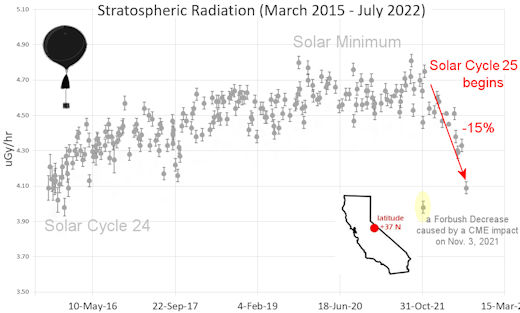
What's going on? Ironically, the radiation drop is caused by increasing solar activity. Solar Cycle 25 has roared to life faster than forecasters expected. The sun's strengthening and increasingly tangled magnetic field repels cosmic rays from deep space. In addition, solar coronal mass ejections (CMEs) sweep aside cosmic rays, causing sharp reductions called "Forbush Decreases." The two effects blend together to bring daily radiation levels down.
.Who cares? Cosmic rays are a surprisingly "down to Earth" form of space weather. They can alter the chemistry of the atmosphere, trigger lightning, and penetrate commercial airplanes. According to a study from the Harvard T.H. Chan school of public health, crews of aircraft have higher rates of cancer than the general population. The researchers listed cosmic rays, irregular sleep habits, and chemical contaminants as leading risk factors. A number of controversial studies (#1, #2, #3, #4) go even further, linking cosmic rays with cardiac arrhythmias and sudden cardiac death.
Technical notes: The radiation sensors onboard our helium balloons detect X-rays and gamma-rays in the energy range 10 keV to 20 MeV. These energies span the range of medical X-ray machines and airport security scanners.
Data points in the graph labeled "Stratospheric Radiation" correspond to the peak of the Regener-Pfotzer maximum, which lies about 67,000 feet above central California. When cosmic rays crash into Earth's atmosphere, they produce a spray of secondary particles that is most intense at the entrance to the stratosphere. Physicists Eric Regener and Georg Pfotzer discovered the maximum using balloons in the 1930s and it is what we are measuring today.
| | The official U.S. government space weather bureau |
| | The first place to look for information about sundogs, pillars, rainbows and related phenomena. |
| | Researchers call it a "Hubble for the sun." SDO is the most advanced solar observatory ever. |
| | 3D views of the sun from NASA's Solar and Terrestrial Relations Observatory |
| | Realtime and archival images of the Sun from SOHO. |
| | information about sunspots based on the latest NOAA/USAF Active Region Summary |
| | current counts of failed and deployed Starlink satellites from Jonathan's Space Page |
| | Authoritative predictions of space junk and satellite re-entries |
| | from the NOAA Space Environment Center |
| | fun to read, but should be taken with a grain of salt! Forecasts looking ahead more than a few days are often wrong. |
| | from the NOAA Space Environment Center |
| | the underlying science of space weather |
 | BestCSGOGambling is the best site for everything related to CSGO gambling on the web |
 | To find reviews of new online casino sites in the UK try The Casino DB where there are hundreds of online casino reviews complete with bonuses and ratings. Alternatively, Online-Casinos.xyz is another massive directory of online casinos listing sites for the UK and Worldwide. Casinos that offer Rupees for bonuses are very generous to Indian players. Find the best online casinos in India at AllCasinos.in Looking for a new online casino? Try Casimpo the new site dedicated to making online casino simple, or check out the new Avenger Slots Casino and Ace Online Casino with over 500 online slots and casino games. |
 | One of the most popular casino games is the Book Of Dead Slot based on ancient Egyptian text, you can find all the casinos with spins at bookofdeadslotsites.com. |
 | When looking for casinos to play online when the weather is bad, you can try casino online trucchi for Italian games. If you are not from Finland you can try the Swedish page Svenska casino online to find suitable games, check out svenskacasinoonline.net. Always check your local laws before playing with real money. |
 | Looking for sports betting companies not registered on GamStop? CasinoGap has presented a list of sites not on GamStop available for UK players. Check and bet online! Would you like to bet at sites not using GamStop? Look at a list of NonStopCasino sites for online betting that aren't on GamStop. Top-rated bookmakers ever! |
| | These links help Spaceweather.com stay online. Thank you to our supporters! |
| | | | | | |

